Zichao Xiao
Multipath Exploitation for Fluctuating Target Detection in RIS-Assisted ISAC Systems
Jun 02, 2024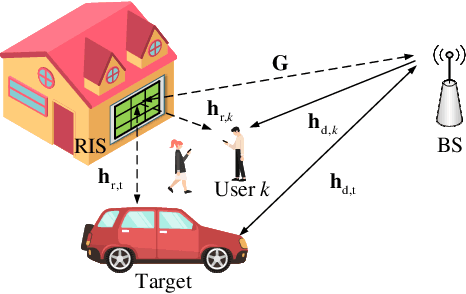
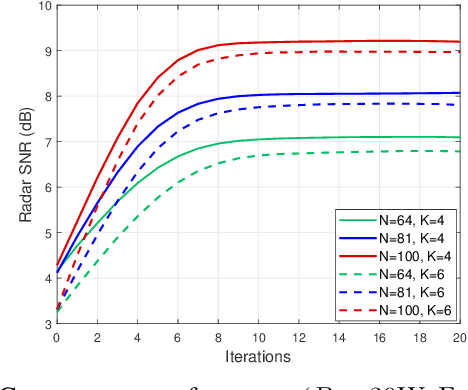
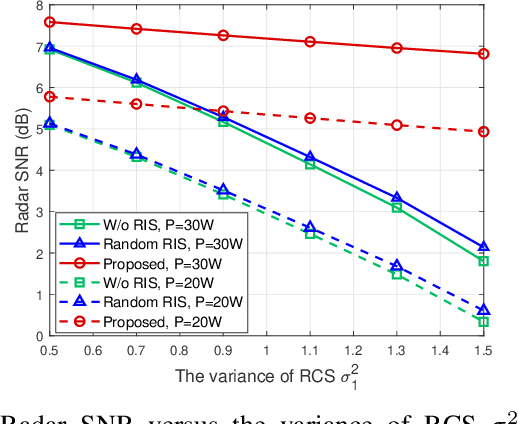

Abstract:Integrated sensing and communication (ISAC) systems are typically deployed in multipath environments, which is usually deemed as a challenging issue for wireless communications. However, the multipath propagation can also provide extra illumination and observation perspectives for radar sensing, which offers spatial diversity gain for detecting targets with spatial radar cross-section (RCS) fluctuations. In this letter, we propose to utilize reconfigurable intelligent surfaces (RIS) in ISAC systems to provide high-quality and controllable multipath propagation for improving the performance of fluctuating target detection and simultaneously enhancing the quality of communication services. To effectively exploit the spatial diversity offered by RIS-empowered multipath, the dual-functional transmit beamforming and the RIS reflection beamforming are jointly designed to maximize the expectation of radar signal-to-noise ratio (SNR). To solve the resulting complex non-convex optimization problem, we develop an efficient alternating optimization algorithm that utilizes majorization-minimization (MM) and alternating direction method of multipliers (ADMM) algorithms. Simulation results illustrate the advantages of multipath exploitation and the proposed beamforming design algorithm for fluctuating target detection in RIS-assisted ISAC systems.
Sparsity Exploitation via Joint Receive Processing and Transmit Beamforming Design for MIMO-OFDM ISAC Systems
Dec 29, 2023



Abstract:Integrated sensing and communication (ISAC) is widely recognized as a pivotal enabling technique for the advancement of future wireless networks. This paper aims to efficiently exploit the inherent sparsity of echo signals for the multi-input-multi-output (MIMO) orthogonal frequency division multiplexing (OFDM) based ISAC system. A novel joint receive echo processing and transmit beamforming design is presented to achieve this goal. Specifically, we first propose a compressive sensing (CS)-assisted estimation approach to facilitate ISAC receive echo processing, which can not only enable accurate recovery of target information, but also allow substantial reduction in the number of sensing subcarriers to be sampled and processed. Then, based on the proposed CS-assisted processing method, the associated transmit beamforming design is formulated with the objective of maximizing the sum-rate of multiuser communications while satisfying the transmit power budget and ensuring the received signal-to-noise ratio (SNR) for the designated sensing subcarriers. In order to address the formulated non-convex problem involving high-dimensional variables, an effective iterative algorithm employing majorization minimization (MM), fractional programming (FP), and the nonlinear equality alternative direction method of multipliers (neADMM) with closed-form solutions has been developed. Finally, extensive numerical simulations are conducted to verify the effectiveness of the proposed algorithm and the superior performance of the introduced sparsity exploitation strategy.
A Novel Joint Angle-Range-Velocity Estimation Method for MIMO-OFDM ISAC Systems
Aug 07, 2023Abstract:Integrated sensing and communications (ISAC) is emerging as a key technique for next-generation wireless systems. In order to enable ubiquitous mobile network and widely deployed base stations with radar sensing functionality, using standard multiple-input multiple-output (MIMO) orthogonal frequency division multiplexing (OFDM) transmitter architectures and waveforms to achieve both satisfactory sensing and communication performance is a crucial task for practical implementations of ISAC. In this paper, we propose a novel joint angle-range-velocity estimation algorithm for the considered MIMO-OFDM ISAC system. The approach is based on classical MIMO-OFDM waveforms widely adopted in wireless communications. Specifically, the angle-range-velocity information of potential targets is jointly extracted by utilizing all the received echo signals in a coherent processing interval (CPI). Therefore, the proposed joint estimation algorithm can achieve larger processing gains and higher resolution by fully exploiting echo signals and jointly estimating the angle-range-velocity information. Theoretical analysis for maximum unambiguous range, resolution, and processing gains are provided to verify the advantages of the proposed joint estimation algorithm. Finally, extensive numerical experiments are presented to demonstrate that the proposed estimation approach can achieve significantly lower root-mean-square-error (RMSE) of angle/range/velocity estimation for both single-target and multi-target scenarios.
Low-Range-Sidelobe Waveform Design for MIMO-OFDM ISAC Systems
May 30, 2023Abstract:Integrated sensing and communication (ISAC) is a promising technology in future wireless systems owing to its efficient hardware and spectrum utilization. In this paper, we consider a multi-input multi-output (MIMO) orthogonal frequency division multiplexing (OFDM) ISAC system and propose a novel waveform design to provide better radar ranging performance by taking range sidelobe suppression into consideration. In specific, we aim to design MIMO-OFDM dual-function waveform to minimize its integrated sidelobe level (ISL) while satisfying the quality of service (QoS) requirements of multi-user communications and the transmit power constraint. To achieve a lower ISL, the symbol-level precoding (SLP) technique is employed to fully exploit the degrees of freedom (DoFs) of the waveform design in both temporal and spatial domains. An efficient algorithm utilizing majorization-minimization (MM) framework is developed to solve the non-convex waveform design problem. Simulation results reveal radar ranging performance improvement and demonstrate the benefits of the proposed SLP-based low-range-sidelobe waveform design in ISAC systems.
Joint Beamforming Design in DFRC Systems for Wideband Sensing and OFDM Communications
Aug 05, 2022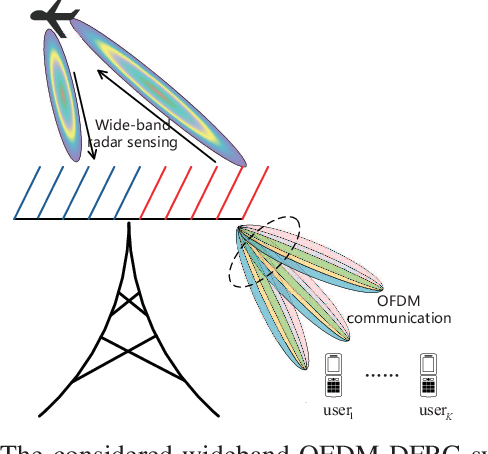
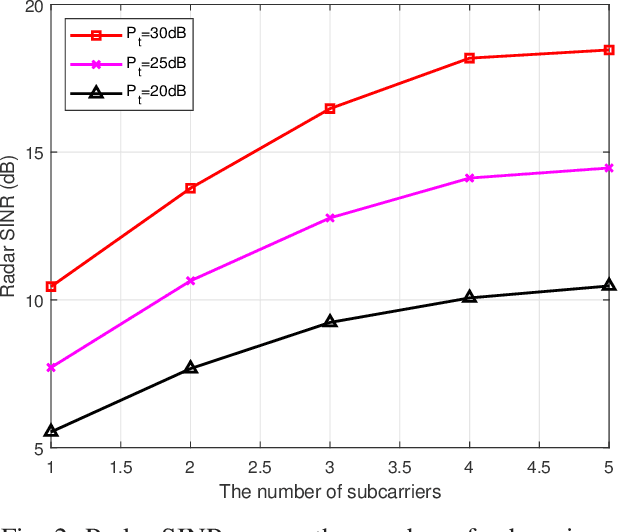
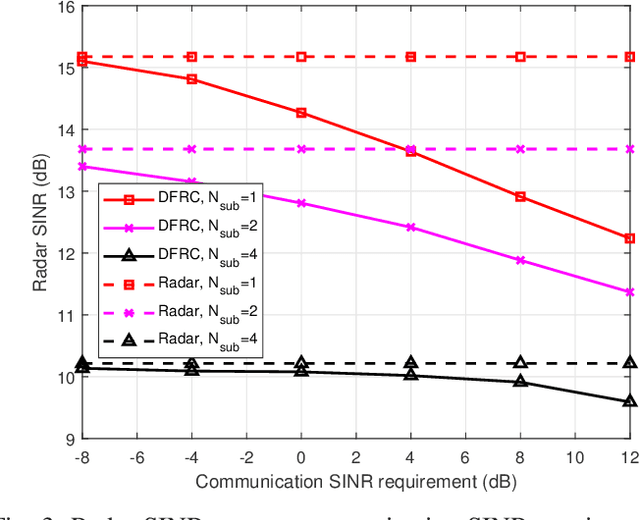
Abstract:Dual-function radar-communication (DFRC) systems, which can efficiently utilize the congested spectrum and costly hardware resources by employing one common waveform for both sensing and communication (S&C), have attracted increasing attention. While the orthogonal frequency division multiplexing (OFDM) technique has been widely adopted to support high-quality communications, it also has great potentials of improving radar sensing performance and providing flexible S&C. In this paper, we propose to jointly design the dual-functional transmit signals occupying several subcarriers to realize multi-user OFDM communications and detect one moving target in the presence of clutter. Meanwhile, the signals in other frequency subcarriers can be optimized in a similar way to perform other tasks. The transmit beamforming and receive filter are jointly optimized to maximize the radar output signal-to-interference-plus-noise ratio (SINR), while satisfying the communication SINR requirement and the power budget. An majorization minimization (MM) method based algorithm is developed to solve the resulting non-convex optimization problem. Numerical results reveal the significant wideband sensing gain brought by jointly designing the transmit signals in different subcarriers, and demonstrate the advantages of our proposed scheme and the effectiveness of the developed algorithm.
Low-Complexity Designs of Symbol-Level Precoding for MU-MISO Systems
May 02, 2022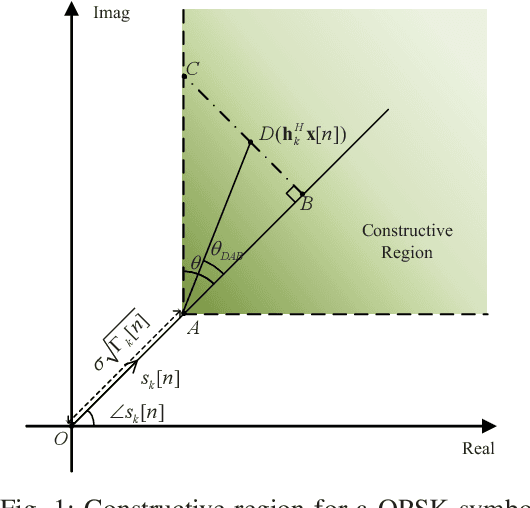
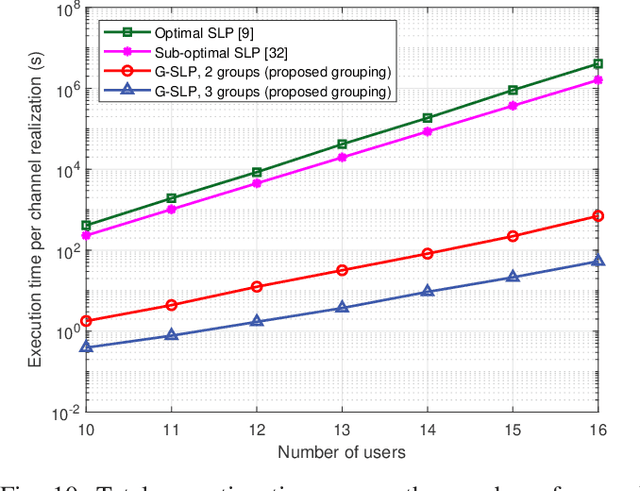
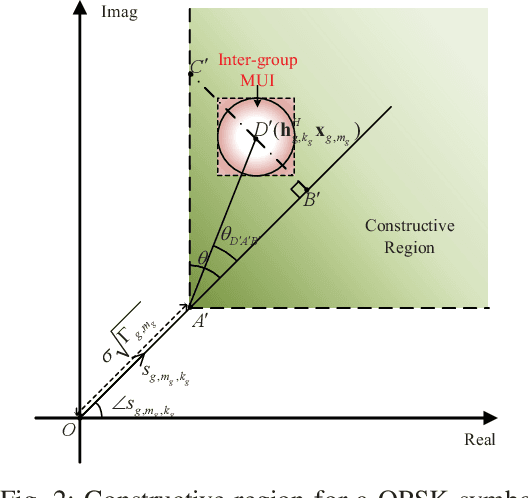
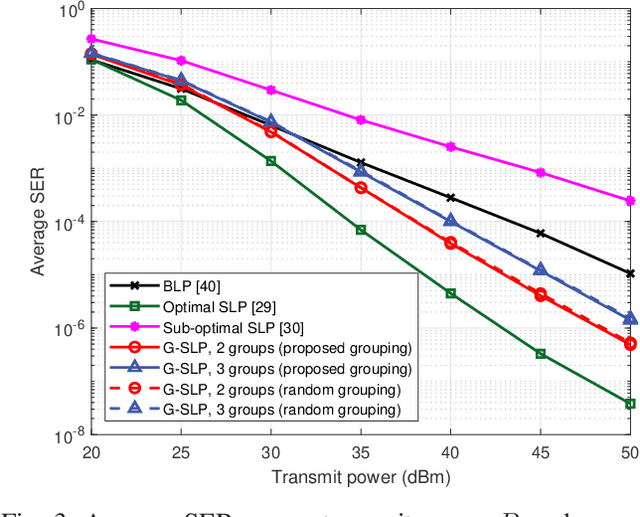
Abstract:Symbol-level precoding (SLP), which converts the harmful multi-user interference (MUI) into beneficial signals, can significantly improve symbol-error-rate (SER) performance in multi-user communication systems. While enjoying symbolic gain, however, the complicated non-linear symbol-by-symbol precoder design suffers high computational complexity exponential with the number of users, which is unaffordable in realistic systems. In this paper, we propose a novel low-complexity grouped SLP (G-SLP) approach and develop efficient design algorithms for typical max-min fairness and power minimization problems. In particular, after dividing all users into several groups, the precoders for each group are separately designed on a symbol-by-symbol basis by only utilizing the symbol information of the users in that group, in which the intra-group MUI is exploited using the concept of constructive interference (CI) and the inter-group MUI is also effectively suppressed. In order to further reduce the computational complexity, we utilize the Lagrangian dual, Karush-Kuhn-Tucker (KKT) conditions and the majorization-minimization (MM) method to transform the resulting problems into more tractable forms, and develop efficient algorithms for obtaining closed-form solutions to them. Extensive simulation results illustrate that the proposed G-SLP strategy and design algorithms dramatically reduce the computational complexity without causing significant performance loss compared with the traditional SLP schemes.
 Add to Chrome
Add to Chrome Add to Firefox
Add to Firefox Add to Edge
Add to Edge